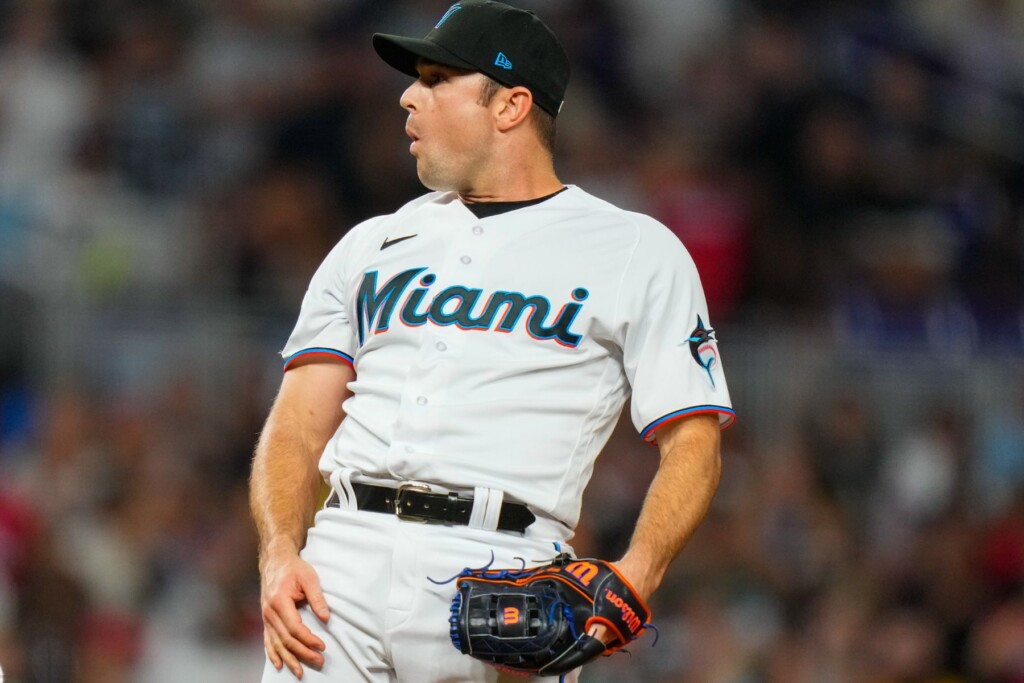The glove was spiked almost as hard as the curveball.
With a wicked 2-2 breaker that dropped into the zone for a called third strike, Texas right-hander Josh Sborz had just closed out the first World Series title in Rangers history. As Sborz flung his mitt to the ground and bounded screaming toward home plate, several burdens were lifted. Gone was the sting of 2011, when the Rangers failed to execute that clinching pitch. Ancient history now. Also banished were much more recent frustrations.
Texas had climbed to this pinnacle despite repeatedly losing its footing whenever a game hung in the balance. In the regular season, the bullpen’s 4.77 ERA was the seventh worst in baseball. Rangers relievers allowed the second most home runs per nine innings in the majors. They also blew the second most saves with 33, and they converted less than half of their save opportunities. Their save rate of 47.6 percent wasn’t just the worst in the big leagues; it was the worst ever by a team that made the playoffs.
“Last year,” says Rangers assistant general manager Ross Fenstermaker, “we left quite a few wins on the table based off the bullpen’s performance.”
But then the playoffs hit. Behind a trio of leverage arms in Sborz, Jose Leclerc, and Aroldis Chapman, plus a host of starters moonlighting as relievers, regular-season weakness turned into postseason strength. Leclerc finished off four playoff wins and posted a 3.29 ERA in 13 appearances. Chapman had a 2.25 mark and Sborz was nearly untouchable with a postseason ERA of 0.75. Those three accounted for nearly half of the bullpen’s playoff innings, and while it wasn’t always pretty—“Chappy was a little terrifying sometimes,” quipped starter Andrew Heaney—it was more than good enough.
Now, with spring training underway, much of the same bullpen cast returns. Chapman and Chris Stratton were the only notable departures, replaced by veteran free-agent signees David Robertson and Kirby Yates. Costing a total of $16 million, they make for a pair of thrifty, although hardly fearsome back-end arms. Robertson is 38 and coming off a Jekyll-and-Hyde season split between the Mets and Marlins. Yates is 36 and only a year removed from missing three consecutive years with elbow injuries.
They are two of the most consequential acquisitions in what, thanks to lingering uncertainty about broadcast rights, has been a muted Rangers offseason. (Meanwhile, the Astros spent $95 million to land Josh Hader, arguably the top closer in the game.) That same limbo has kept Texas from addressing its rotation—namely, bringing back Jordan Montgomery. While the team waits for the midseason returns of Jacob deGrom and Max Scherzer, the bullpen will have to carry an even heavier load.
Entering 2024, a question remains. The bullpen may have been good enough in October. Can it be good enough again?
The key, Sborz says, was health.
Early last season, his shoulder began to bother him, but he pitched through it. Then his hamstring began to bark. He pitched through that, too. On July 1, when the righty tossed a scoreless frame in a win over Houston, his ERA stood at 2.62. But then his ailments went from nagging to shrieking. Over the next two months, he allowed 22 runs in just 15 1/3 innings, for an ERA of 12.91. His fastball lost its zip. His curveball lost its bite. Finally, after a meltdown against those same Astros in early September, Sborz was placed on the injured list.
It was like that for the entire relief corps. “I think we had a good bullpen last year,” he says. “Injuries just kind of wore us out.” Leclerc didn’t feel great coming into the year. Veterans Ian Kennedy and Will Smith struggled to pick up the slack. “It’d be one injury and one guy would step up,” Sborz says, “and he’d get hurt because he was pitching so much.”
The fix was simple: rest and the bright lights of October. Sborz missed three weeks, returning with three games left in the regular season. His arm was strong, a feeling that persisted all the way through the World Series run. If there’s a reason to be optimistic about the bullpen heading into the Rangers’ title defense season, it’s this: when the team’s best relievers were healthy, they were nails. And they’re healthy now. The 30-year-old Sborz is fresh and playoff-seasoned. So is Leclerc, the postseason’s other relief hero. “I feel way better than last year,” he says.
Those two make an intriguing one-two punch at the back of games, but as last year proved, a manager needs far more than two reliable leverage arms. That’s why there are lockers at Surprise Stadium for Robertson and Yates, who represent solid if not momentous upgrades over the likes of Chapman, Smith, and Kennedy.
Coming off Tommy John surgery, Yates enjoyed a successful 2023 with Atlanta, pitching to a 3.28 ERA and striking out nearly a third of the batters he faced, although he struggled with walks. He may never fully regain the dominant form he had with the Padres in 2019, when he led the majors with 41 saves, but his splitter remains a weapon and his command should sharpen the more he progresses from his surgery.
For his part, Robertson has been the picture of consistency. The righty owns a career 2.90 ERA in nearly 800 appearances and had a 2.72 ERA over the last two seasons. Though he was hit around last year after a midseason trade to the Marlins, the Rangers believe in his track record and his cut fastball.
The result, team brass hopes, is that manager Bruce Bochy and pitching coach Mike Maddux aren’t so hamstrung late in games, “so you’re not as nervous as maybe you were at times in 2023,” says Fenstermaker. And if best-laid plans go awry and nerves again spike, the Rangers will rely on an old baseball strategy.
They’ll figure it out on the fly.
If there’s a truism in baseball, it’s this: however you think things will play out with your bullpen, it probably won’t.
Arms will break down. Relievers with reliable ones will scuffle. Strong performers will rise from obscurity, and the cast of characters will constantly change. There will be call-ups and send-downs, waiver claims and trades. Major League clubhouses are stocked with surplus lockers to accommodate all the comings and goings.
That volatility can be a bug—managers and general managers love nothing more than cold, hard predictability—but it can also be a feature. When things aren’t working in the lineup or in the rotation, the options are limited. But a bullpen is hardly ever stuck in place. Struggling relievers can be optioned and promising ones can be called up. A quality arm is almost always available on the waiver wire or in a trade. If you’re on top of things and willing to experiment with a bunch of combinations, you can sometimes rebuild a crippled airplane in midair.
Look no further than the team Texas beat in the World Series. As the Diamondbacks surprisingly claimed the National League pennant, they relied heavily on a group of relievers who hadn’t been on the team a year earlier. Relief star Kevin Ginkel had struggled for multiple years in the minors before righting his career. Closer Paul Sewald came over in a deadline trade with the Mariners. Ryan Thompson was cast off by the Rays in August and signed to a minor-league deal, while Andrew Saalfrank was an obscure prospect until the final weeks of the regular season. Those four pitched more than half of the team’s relief innings in October, almost all of them in leverage situations.
Like Texas, Arizona had one of the worst bullpens in the majors before those moves. The Rangers hope they’re in a better position now than they were back then, but if they need to adjust, they’ll have options. As it stands, Leclerc, Sborz, Robertson, Yates, and Brock Burke own bullpen spots, leaving two or three jobs up for grabs. Jonathan Hernández might have a leg up for one, and a host of others are vying for what remains. There are experienced bullpen arms on minor-league deals, including Diego Castillo, Shane Greene, and Chasen Shreve. There are young starters who could be called upon to lap up innings, such as Jack Leiter, Cole Winn, and Owen White. The Rangers can cycle through all of them until someone catches on.
And those are just the internal options. If the defending champs play up to their talent, with an enviable lineup powering them to contention and a midseason rotation boost from Scherzer and deGrom, there always will be relievers for the picking on the trade market. “It’s the easiest area of the club to upgrade at the deadline,” Fenstermaker says, “because there’s not a lot of utility for one-inning relievers when a team is not competitive.”
How much utility the Rangers have will depend on how competitive they are. Texas won the title, but unlike recent offseasons, the Rangers haven’t won the winter. Despite whatever unspoken payroll limits they have—instead of bursting through it like the Kool-Aid man, the team has barely surpassed the first luxury tax threshold—they have tried to make their bullpen better. It was a unit that led fans to drink, first in regular-season despair and then in postseason elation. It’s stronger now than it was then, but how much stronger depends on which version you believe it to be.
The Rangers know which they’d pick.
“Yeah, we’re coming here to help,” Yates says, “but we’re also coming here to help a bullpen that was really good in the playoffs. That’s the way I look at it.”






